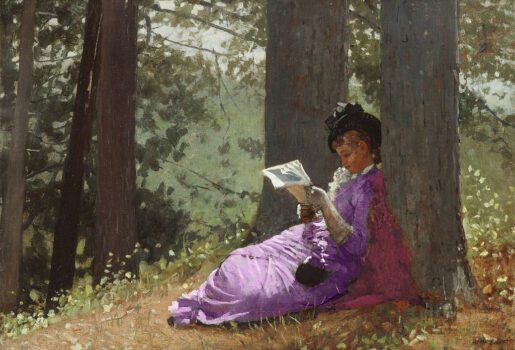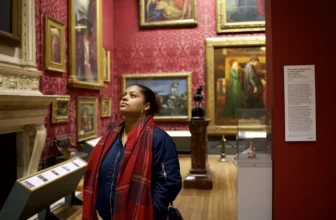Meaning of Girl Reading Under an Oak Tree by Winslow Homer
In the gentle hush of nature, beneath the sprawling limbs of a towering oak, a solitary figure sits, lost in the pages of a book. Winslow Homer’s Girl Reading Under an Oak Tree captures a moment of serene introspection, a fleeting summer’s stillness painted in delicate brushstrokes and tender color. The painting, at first glance, appears simple , a girl absorbed in reading under a tree , but upon closer observation, it becomes a window into a deeper, richer world of symbolism, artistic evolution, and cultural reflection.
This piece, though not as widely known as Homer’s seascapes or Civil War scenes, carries with it a quiet significance that has made it a subject of interest for scholars, art lovers, and historians alike. What did Homer intend to convey with this intimate depiction? Who is the girl? What does this moment of solitude mean in the broader context of 19th-century American life? To understand Girl Reading Under an Oak Tree, we must travel back to the time and mind of Winslow Homer himself.
Who Was Winslow Homer?
Born in Boston in 1836, Winslow Homer began his career as a commercial illustrator before transitioning into one of the most celebrated American painters of the 19th century. Largely self-taught, Homer was a master of capturing the American experience, from the harrowing realities of war to the idyllic charm of rural life and the raw power of the sea. His ability to combine realism with a deep emotional undercurrent helped redefine American art in the post-Civil War era.
While many of his most famous works revolve around dramatic maritime scenes or the aftermath of battle, Homer also had a sensitive eye for everyday moments. He was especially adept at portraying women and children in natural settings, often exploring themes of innocence, introspection, and the tension between solitude and society.
When and How Was Girl Reading Under an Oak Tree Painted?
Girl Reading Under an Oak Tree was painted around 1879, a pivotal moment in Homer’s artistic evolution. By this time, he had left behind his career as an illustrator and was beginning to explore a more personal, painterly style. It was also a time when Homer was deeply engaged with rural American life, often painting scenes from the countryside and small towns of New England.
The painting likely emerged from Homer’s time in Houghton Farm, a rural retreat in New York State where he stayed during the late 1870s. This period marked a turning point in his style, moving from narrative-heavy illustrations to more contemplative and atmospheric compositions. At Houghton Farm, Homer found inspiration in the natural surroundings and the simplicity of agrarian life. The painting was probably composed en plein air , painted outdoors , a method that allowed Homer to observe light, shadow, and color with immediacy and truthfulness.
Using watercolor, which had become one of his favorite mediums during this time, Homer delicately rendered the figure of the girl with a loose yet deliberate technique. Watercolor allowed him to infuse the painting with a sense of transparency and softness, perfectly suited to the tranquil subject matter.
What Is Happening in the Painting?
At its surface, the scene is straightforward: a young girl sits beneath a large oak tree, her body partially reclined, completely absorbed in a book. She appears unaware of the viewer, fully immersed in the world on the page before her. The sunlight filters gently through the leaves, dappling her dress and the ground with subtle patterns of light and shadow.
There is no drama, no movement, no other figure to distract from her solitude. The composition is simple but effective. The vertical presence of the oak tree provides a natural frame, while the girl’s posture and the surrounding environment guide the eye inward. This careful balance between figure and landscape demonstrates Homer’s ability to harmonize subject and setting.
But this seemingly quiet scene holds deeper meanings when considered within the historical and cultural context in which it was painted.
What Does Girl Reading Under an Oak Tree Represent?
In many ways, the painting represents a moment of personal freedom and intellectual engagement. In the 19th century, the image of a woman or girl reading was both a common and contested motif. Reading symbolized knowledge, imagination, and autonomy , qualities that were not always encouraged in young women of the time.
By depicting a girl not in domestic labor or social activity but in an act of solitary reading, Homer offers a progressive and tender vision of female agency. The oak tree , long a symbol of strength, stability, and endurance , serves as a natural metaphor for the girl’s potential intellectual and emotional growth. She is grounded, nurtured by nature, and untroubled by external demands.
Moreover, the painting can be read as an ode to leisure, tranquility, and the inner life. At a time when industrialization was transforming American society and cities were growing rapidly, Homer’s rural scenes offered a nostalgic and perhaps idealized view of a simpler, more reflective existence.
Symbolism and Deeper Meaning
The symbolism in Girl Reading Under an Oak Tree is subtle but powerful. Let’s unpack some of the most compelling elements:
1. The Oak Tree
The oak is one of the most storied trees in Western symbolism. Traditionally associated with wisdom, endurance, and strength, it may here be a stand-in for the intellectual and spiritual shelter provided by books and learning. The fact that the girl reads under this tree suggests a metaphorical connection between nature and knowledge , both sources of nourishment and growth.
2. The Book
The act of reading itself is deeply symbolic. Books in 19th-century art often represented education, enlightenment, and moral instruction. However, in this case, the girl is alone and not under the supervision of an adult. This might hint at a shift from didactic to personal reading , an engagement with stories, emotions, or ideas of her own choosing. In a broader sense, the book is a portal, offering her a means of escape, exploration, and independence.
3. Solitude
Homer was fascinated with the theme of solitude. Unlike loneliness, which carries a sense of absence or lack, solitude in Homer’s work often suggests peace, introspection, and strength. The girl’s isolation is not melancholy but meditative. She is at ease in her own company, part of the landscape rather than apart from it.
4. Light and Color
Homer’s use of natural light in this painting is masterful. The filtered sunlight creates a dreamlike atmosphere, softening the edges of reality and emphasizing the girl’s inward focus. The colors are earthy and subdued, reinforcing the harmony between human and environment.
Artistic Style and Technique
Girl Reading Under an Oak Tree is executed in watercolor, a medium that Homer elevated to new heights in American art. Watercolor was often seen as secondary to oil painting, but Homer demonstrated that it could be just as expressive and complex. His mastery of the medium allowed him to play with transparency, layering, and color variation in ways that brought a living quality to his work.
The painting reflects Homer’s broader move toward realism infused with emotional depth. While not hyper-detailed, the work captures the essence of its subject through gesture and mood. This approach aligns with the American Realist movement of the time, which sought to portray everyday life with sincerity and respect.
At the same time, there are elements of Impressionism in the light handling and spontaneous brushwork , although Homer was never fully aligned with the European Impressionists, his work did overlap with some of their concerns, particularly in the late 1870s and early 1880s.
Cultural and Historical Context
The 1870s were a period of cultural transition in the United States. The Civil War had ended only a decade prior, and the nation was grappling with Reconstruction, modernization, and shifts in social roles , especially for women. Education for girls was expanding, and the ideal of the “cultivated woman” was gaining prominence in middle and upper-class society.
In this context, Homer’s painting subtly supports the idea of intellectual development for women, not through overt messaging but through the quiet dignity of the scene. The girl is not a decorative object, not a symbol of domesticity or romance, but a thinker , a reader , someone engaged in her own intellectual world.
Where Is Girl Reading Under an Oak Tree Located Today?
Today, Girl Reading Under an Oak Tree is housed in the Museum of Fine Arts, Boston. The museum has one of the most significant collections of Winslow Homer’s works, and this particular piece is an excellent example of his transition from illustration to fine art.
The painting continues to be studied and appreciated not only for its aesthetic beauty but also for its cultural resonance and emotional sensitivity. Visitors to the museum often find themselves lingering in front of it, drawn into the same quiet that surrounds the girl in the painting , a pause from the noise of the modern world, an invitation to reflect.
Why This Painting Still Matters
Girl Reading Under an Oak Tree is a testament to the enduring power of simplicity in art. There is no action, no grand statement, and yet it speaks volumes about human experience , particularly the quiet, often overlooked inner lives of women and girls. Winslow Homer’s gentle brush preserves not just a scene, but a feeling: the serenity of being alone with one’s thoughts, the richness of a book, the comfort of nature’s embrace.
In an age where distraction is constant, this painting reminds us of the beauty of stillness and the importance of reflection. It celebrates not just the act of reading, but the freedom to read, to think, to grow. In that way, the girl under the oak tree is all of us , searching, imagining, and finding ourselves in the quiet spaces between the branches.




